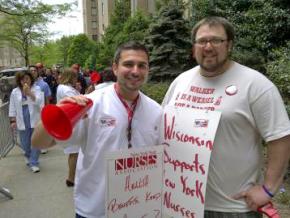Rank-and-file victory for nurses in New York
, a pediatrics emergency room nurse at Jacobi Hospital in New York City, reports on a victory for rank-and-file reformers in his union.
AT A critical time for health care unions, a rank-and-file, staff-nurse-led slate was elected to the Board of Directors of the 37,000-strong New York State Nurses Association (NYSNA). The landslide victory will give reformers a big majority on the 13-member body--the slate will have the power to make sweeping changes in the remaining unelected leadership positions within the union.
The slate, called the New York Nurses for Staffing, Security and Strength--or "S3"--ran on a platform of massively increasing resources to organize for safe staffing levels and focusing on how to win fair contracts throughout the state.
"It's a new day for RNs and patients in New York," said President-Elect Patricia DiLillo. "We are extremely gratified by the confidence of RNs throughout New York who have sent an unmistakable message to hospital employers and nurses alike that they want a strong voice to fight to protect our patients, our communities, our colleagues and our families."
The current leadership has failed to mount any significant contract campaign at most of the facilities where the NYSNA represents nurses. Where contract campaigns do exist, they are being led by members of the S3 slate and their supporters.

In New York City, 22,000 nurses are currently working without a contract, including the more than 8,000 nurses in New York's public hospital system, who have been without a collective bargaining agreement for more than a year and a half. For New York City's public-sector nurses, the city's current offer is a wage freeze--while Mayor Michael Bloomberg attempts to create an additional reduced-benefit tier in the city's pension system.
Another significant issue in the election was democracy and transparency. The current leadership was known for attempting to discipline and marginalize critical voices, at times even working with management to undermine the credibility of certain members within the hospital bargaining units. "Instead of leadership from NYSNA, we have experienced accommodation to hospital managers and government bureaucrats," said incoming Treasurer Pat Kane. "Those days are over, once and for all."
Dissatisfaction with the current leadership runs deep--unionized staff for the NYSNA came within 48 hours of going out on strike in the spring.
Now, in a last-ditch effort to hang on to power, the current NYSNA leadership has filed charges against the S3 slate, erroneously alleging that S3 received material support from another union, the NNU. Thus, the first challenge the new leadership will face is to take office--and that may necessitate expensive litigation and organizing resources.
All of this is occurring in the face of the most serious offensive by employers, both public and private sector alike, that nurses have ever witnessed.
THE S3 slate also highlighted a critical issue within nursing organizations such as NYSNA--the inherent conflict in having collective-bargaining representation subsumed in a professional association, which can admit, and be led by, nurse executives and managers, who can be management-minded. The professional association model has been a contentious issue for decades among workers whose professions require college-level degrees, such as teachers, doctors and nurses.
For nurses, collective bargaining originated with the American Nurses Association (ANA). But within the last two decades, different formations have split from the model represented by the ANA and its state-level affiliates--many of these new formations have recently been reorganized within the National Nurses United union.
As attacks on nursing intensified, the inability of a professional association to respond adequately has become more and more apparent, leading workers to look to organizations reflecting the new models of organizing. In the NYSNA, this will be the first time that staff nurses have dominated the board of directors in its over-100-year history.
The S3 victory could shift dynamics within the New York City labor movement. Pattern bargaining, which all public-sector unions previously relied on for setting the parameters of negotiations, is now a thing of the past. Instead of accepting the current framework of concessionary bargaining and attempting to carve out less-bad side deals with Bloomberg's office, as some city unions have chose to do, the S3 slate has vowed to accept no concessions, build solidarity, and mobilize a fight.
"I think that nurses are an extremely valuable resources, and I think we should be respected and rewarded for the work we do," said Anthony Ciampa, newly elected director-at-large. Anthony has helped spearhead a contract campaign at Columbia-Presbyterian, which employs over 3,000 nurses, the largest facility represented by NYSNA. "I don't think any concessions should be made at all."
This change in leadership couldn't have come at a better time. Within the last week, nurses at Brooklyn Hospital were unilaterally dropped from the hospital's health care plan, only to be recently reinstated. They responded with a successful strike vote. Across New York in the last year, nurses in the private sector have been told that they will have to contribute to their health plans for the first time.
What can be accomplished in the short term is open to question. The NYSNA's membership has been consciously demobilized over a period of years. But anger remains high. But the victory has given rank-and-file activists a sense of hope.
"I think the main focus is to not let management strip away the hard things we've won over the years," said Ciampa. "They're busting up unions everywhere. The government is not exactly in our favor. The real power is in the people. We're the backbone of the industry. The simple fact is that the nurse cannot be replaced."


